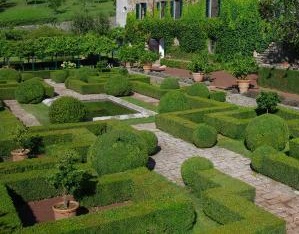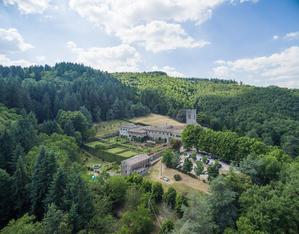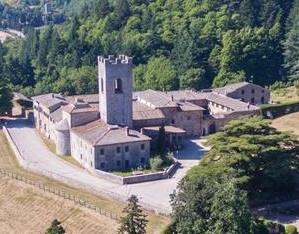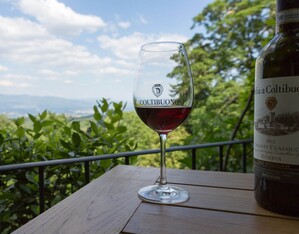The wooded Chianti landscape is the backdrop to Badia a Coltibuono former Vallombrosian monastery now villa, with its charming garden inspired by a Medieval “hortus conclusus”.
Badia a Coltibuono, is located at the top of a hill not far from the important Cetamura Etruscan settlement, where the crest of the hill marks the border between Chianti and Valdarno, on the road that connects Gaiole in Chianti with Montevarchi. Today Coltibuono is still surrounded by vast conifer woods originally planted by the monks followers of Saint John Gualbert, San Giovanni Gualberto. Since the Middle Ages, Badia has been the centre of a vast agricultural and wine estate that expanded over the centuries thanks to donations from the land owners of the area. The name “Badia a cultus boni” (Abbey for a good harvest) was chosen by the monks for good fortune. The earliest mention of “Chianti wine” can be found in the late 12th-century records preserved in abbey’s archives. The garden, bordered by a long wall along one of the two long sides of the property, has been replanted in recent years but still presents clear traces of the ancient Medieval garden layout. The expansive rectangular space is divided by orthogonal paths partly covered by a rustic grapevine pergola with wisteria and common laburnum plants. The biggest section – that can be seen from the monastery windows, today a private residence – presents a geometric design with tall square boxwood hedges and large spheres at the corners; at the centre there is a simple rectangular stone basin. At the bottom of the garden, bordering the road, there is another small formal garden that can be accessed by some steps.
Highlights

A “modern” Medieval garden
The garden has been skilfully designed as a modern take on a Medieval garden, with geometrical garden beds home to aromatic and officinal plants, flowering perennial grasses, peonies, raspberry bushes, and a long grapevine pergola.

An untouched landscape
The most remarkable feature of Abbazia di Coltibuono is the outstanding landscape in which it is set, with oak tree woods serving as background to the architectural complex and its exquisite garden..

The Badia
The badia, the abbey, still presents most of its original mid-11th-century structure that was erected when monk Giovanni Gualberto received as a gift from the powerful feudal lords the local church of San Lorenzo a Coltibuono for the purpose of building a residence for the clergy and a lodging place for pilgrims.

An organic farming estate
The Coltibuono land has been producing excellent wines and oils for a thousand years. A tradition that continues today in the name of environmental sustainability and organic productions. Here, at around an altitude of 300 metres, the Massal selection Sangiovese has found over the centuries the ideal conditions in the clayey-limestone earth of the area. Following the most authentic Chianti tradition, antique vines such as Canaiolo, Ciliegiolo Pugnitello, and Sanforte have been preserved or reintroduced.
 Badia a Coltibuono
Contacts
Badia a Coltibuono
Contacts
Contacts
Telephone:- +39 0577 74481
- +39 3311554691
Fax: +39 0577 744839
Address
Località Badia a Coltibuono
53013, Gaiole in Chianti (SI)
 Badia a Coltibuono
Opening times and prices
Badia a Coltibuono
Opening times and prices
Opening hours
Visits to the Badia (with or without tasting) take place every day in the afternoon, upon reservation.
Pricing
Guided tours, by reservation only, of the Badia with tasting of two wines:
- € 10 per person
Guided tours of the Badia only (always by appointment)
- € 7 a persona.
For other types of visits and tastings offered by the Badia, consult the website
 Badia a Coltibuono
How to get there
Badia a Coltibuono
How to get there
Address
Località Badia a Coltibuono
53013, Gaiole in Chianti (SI)
Latitude: 43.494765
Longitude: 11.449528
How to arrive by road
From Florence
- You can reach Badia a Coltibuono by taking the A1 motorway southbound. At the Valdarno exit proceed in the direction of Montevarchi and then take the SP 408 in the direction of Siena for about 16 km until the junction, on the right, to Badia a Coltibuono.
From Siena
- Take the SP 408 towards Gaiole in Chianti – Montevarchi. 6 km after Gaiole turn left onto SR 429, at the crossroads you will find, on the right, the junction to get to Badia a Coltibuono.
How to arrive by train
Reach the station of Montevarchi – Terranuova. Continue by taxi to Badia a Coltibuono.
Additional directions
Distances from Badia a Coltibuono to main airports
- Rome 280 km.
- Milan 413 km.
- Bologna 162 km.
- Pisa 142 km.
- Florence 74 km.
 Badia a Coltibuono
Services/Accessibility
Badia a Coltibuono
Services/Accessibility
Services
The Badia a Coltibuono Restaurant, housed in the old stables of the Villa, offers organic products and raw materials of Tuscan origin.
Badia a Coltibuono offers various types of cooking classes, to discover recipes, dishes and wines of the Tuscan tradition. For information on the types of courses, consult the website
In the premises of the old Osteria, situated along the access road to the Badia, it is possible to taste and buy all the products of Badia a Coltibuono and local handicraft objects. For information consult the website
Badia a Coltibuono, the ancient abbey of the XI century, today farm and agritourism, preserves its original structure. Guests can stay in comfortable renovated apartments or in the ancient monks' cells, transformed into rooms. For information and bookings consult the website
 Badia a Coltibuono
Private events
Badia a Coltibuono
Private events
Badia a Coltibuono allows you to organize in its spaces, both inside and outside the structure, high-profile private events such as weddings, parties, but also corporate events and study meetings.
 Badia a Coltibuono
Itineraries
Badia a Coltibuono
Itineraries
You could find the garden in these itineraries
 Favorite saving result
Favorite saving result
 Warning!
Warning!
You've have to sign up or sign in to add this element to your favorites.
